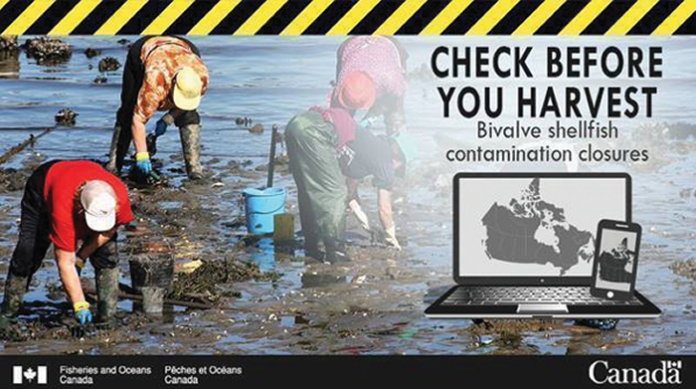• Extreme seasonal low tides and the good weather have led to a significant increase in illegal recreational shellfish harvesting in the Boundary Bay area (Area 29).
• DFO fishery officers regularly patrol this area, and adjacent beaches, for enforcement and public education outreach, however, due to the Pandemic health and travel restrictions and economic pressures, many new harvesters who may not be familiar with the rules, regulations and public health and stock conservation concerns, are fishing for the first time in those areas.
• These non-traditional harvesters may not be aware that the entire lower mainland, including Boundary Bay, is closed to the harvest of bivalves because of sanitary reasons and the risk of toxic shellfish poisoning.
• Plus, a significant number of recreational harvesters who are aware of the rules, chose to ignore them, and the numerous posted signs in the area that warn of the closures and health risks associated with consuming those bi-valves.
• The current low tides are also enabling recreational harvesters to access areas that are beyond the US/Canada markers that denote the border line and some Canadians are crossing this, sometimes unknowingly, and illegally entering the US to access flounder and crab.
• Any incursions across the border are viewed by US authorities as illegal and could pose serious consequences for harvesters. Potential charges could range from unauthorized crossing of the US border and being in America without authority, to multiple Washington State fishing violations including fishing without a licence and failure to comply with Washington State size and possession limits, plus other US prohibitions.
• There are also Canadian rules and regulations that must be complied with when harvesting recreational shellfish, and other species, which are strictly enforced by DFO fishery officers. For Area 29, these include:
o the daily limit for legal-sized Dungeness crab is four per licenced individual;
o the combined Dungeness and Red Rock crab limit, is four in total, with no retention of shore crab permitted.
o Harvesters cannot retain undersized crab – for Dungeness the minimum size limit is 165mm and for Red Rock it is a minimum of 115mm.
• Due to significant conservation concerns and the importance of protecting breeding stocks, the Department has zero tolerance for the retention of undersized crab, or female crabs.
• Gross overfishing and retention can also lead to serious fines, ranging from $100 up to $1000 per violation, and legal consequences, including an automatic court appearance requirement at a certain fine level, plus the potential seizure of gear, vessels and vehicles.
• Harvesters can be charged with multiple violations which result in cumulative automatic fines including:
o $100 for fishing without a licence;
o $250 for fishing in a closed area;
o $150 for catch and retain one more than the daily quota, plus $50 for each additional fish/shellfish up to $1000;
o $150 for fishing with prohibited gear or by prohibited method;
o $150 for catch and retain one undersized crab, plus $50 for each additional undersized crab, up to a maximum of $1000,
o failure to forthwith return fish to water or failure to release in the least harmful manner is $50 for each animal;
o molest or injure a fish is $250, i.e. using any sharp pointed device (such as rakes or spears), to harvest crab. This is illegal since it damages the carapace or shell protecting internal organs.
o failing to comply with licence conditions, i.e. prohibited retention of female crab;
o possess fish or shellfish which cannot be readily measured (i.e. removing the carapace from a crab) is $50 each up to $1000, plus an automatic Court Appearance Notice for numbers possessed over and above that.
• Other species that harvesters can fish in the area include fish such as flounder and sole, but they are also covered by rules and regulations. The daily possession of flounder/sole in Boundary Bay is 8 per person, they cannot be caught with a net, nor can they be speared; finfish such as flounder or sole must be caught by rod and reel only.
• Everyone participating in fishing activities must know and abide by the rules, which can be found on the DFO website. Each harvester must have a valid tidal waters sport fishing licence, even children under 16 who do not have to pay a fee, but still need a licence and must fish their own quota.
• DFO has a mandate to protect and conserve marine resources and to prosecute offenders under the Fisheries Act. It ensures and promotes compliance with the Act and other laws and regulations through a combination of land, air, and sea patrols, as well as education and awareness activities.
• As part of DFO’s work to end illegal activity, the Department asks the public for information on activities of this nature or any contravention of the Fisheries Act and regulations. Anyone with information can call the toll-free violation reporting line at 1-800-465-4336, or email the details to [email protected].
The following links provide more information:
• Shellfish harvesting and safety (dfo-mpo.gc.ca)
• Crab harvesting information – BC sport fishing guide | Pacific Region | Fisheries and Oceans Canada (dfo-mpo.gc.ca)
• Recreational harvesting information for Area 29 – https://www.pac.dfo-mpo.gc.ca/fm-gp/rec/tidal-maree/a-s29-eng.html



